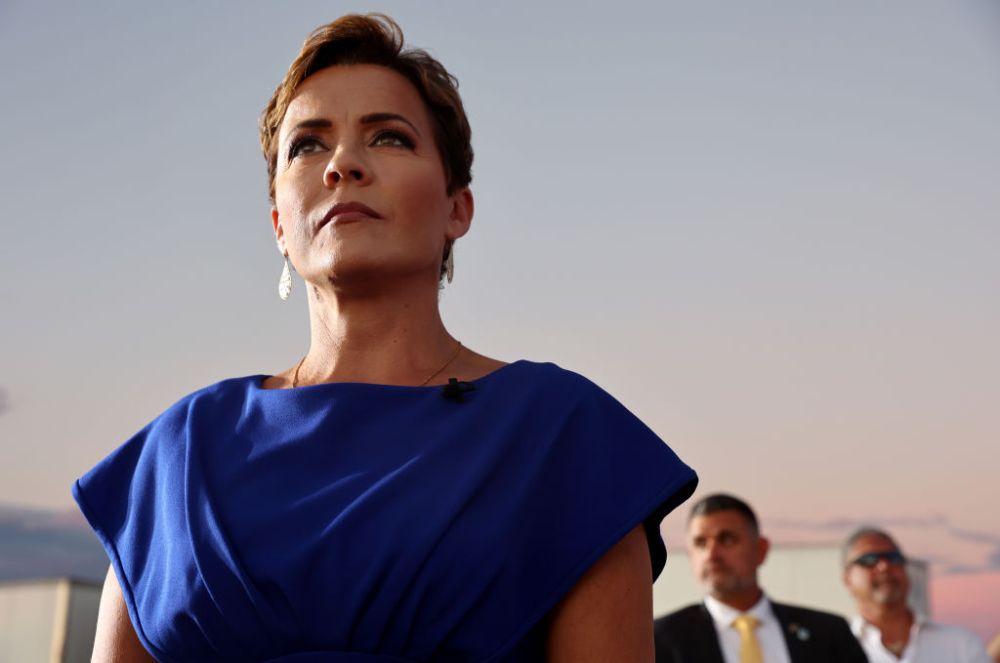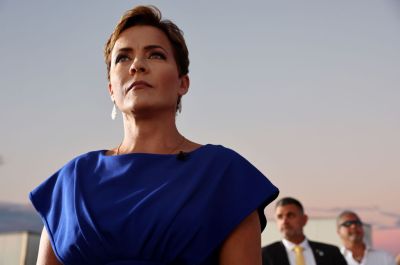Quotes of the Week: Democrats Dissent on Abortion Closing Argument
James Carville: “A lot of these consultants think if all we do is run abortion spots that will win for us. I don’t think so. It’s a good issue. But if you just sit there and they’re pummeling you on crime and pummeling you on the cost of living, you’ve got to be more aggressive than just yelling abortion every other word.”
Bernie Sanders: “I am alarmed to hear the advice that many Democratic candidates are getting from establishment consultants and directors of well-funded Super Pacs that the closing argument of Democrats should focus only on abortion. Cut the 30-second abortion ads and coast to victory. I disagree. In my view, while the abortion issue must remain on the front burner, it would be political malpractice for Democrats to ignore the state of the economy and allow Republican lies and distortions to go unanswered.”
These Polls Are Driving Me Insane
I’ll try to keep this short because I know you are probably sick of hearing me rant about this. If you’d like to hear someone else rant about it, I have found myself going back several times to this clear and helpful explanation by pollster Kristen Soltis Anderson. But the closer we get to the election, here’s just a taste of some of the sloppier polling coverage that has stood out to me:
- Headline from Washington Post: “Half of voters say climate change is important in midterms, poll finds.” That is true. But here is an alternative headline they could have drafted from the exact same data: “Climate Changed ranks LAST in issues for voters this fall—after the economy, inflation, education, abortion, crime and immigration.”
- Or there’s this snippet from Axios, “Nearly four out of 10 Republicans and one in four Democrats say they'll blame election fraud if their party doesn't win control of Congress in November, in the latest wave of the Axios-Ipsos Two Americas Index.” Also true. But this ignores a pretty basic asymmetry: Republicans are heavily favored to win the House. Ask college football viewers what they’d think if No. 1 Alabama lost to Northwestern next week, and I’d expect most Northwestern fans to shrug and a sizable number of Alabama to hypothesize that something untoward would have to have happened. The point being, if you’re trying to figure out whether Alabama fans are more likely to buy into football rigging conspiracy theories, that question wouldn’t get you any good data. Back to the Axios question, the more shocking result is that 25 percent of Democrats think election fraud is the best explanation if they lose an election that everyone says they are going to lose. Quick fix: Limit the question to the Senate next time!
- How about this question that I found buried in a Politico survey: “Who do you trust more to handle abortion access?” Not surprisingly, 52 percent of respondents picked Democrats—22 points higher than Republicans. But this isn’t an issue in which both parties offer different solutions to an agreed upon problem. Both parties, for example, agree that inflation and crime are bad even if they differ on how bad or what to do about it. When it comes to abortion, though, one party is trying to limit abortion access. So from a factual standpoint, the answer as to which party is even offering abortion access should be Democrats. The question they were trying to ask was, “Who do you trust more to determine when abortions should be legal?” I think it’s fair to assume that quite a few of the respondents who picked the Republican Party were answering the question that they meant to ask, but the real question is how many who picked the Democratic Party were responding consciously or unconsciously to the framing of the question.
College Republicans Are an Endangered Species
A fascinating survey from the Center for the Study of Partisanship and Ideology came out last week looking at college students’ political ideology and demographics. The issue isn’t just about whether college campuses are liberal (they are), but what happens when college students are presented with a wildly unrepresentative community of viewpoints in which religion is virtually non-existent, race correlates nearly perfectly with political ideology, and the gender gap is three to five times larger than it is in the general population.
Remember, college graduates have an outsized effect on our politics for a few reasons. First, they are staffing campaigns, and it’s created an interesting asymmetry. If college students tend to be more liberal on the whole, then Republican and Democratic campaigns are staffed by people who are more liberal than their voters. But that means very different things in practice. The Republican operatives are bilingual—fluent in the language of the left while also learning to speak conservative through their own extracurricular study of right-wing thinkers who weren’t represented on campus. Democratic campaign staffers, on the other hand, learned only to speak progressive. These Dem operatives often don’t know how unrepresentative they are of their voters and instead cater to the people they’ve been surrounded by both during and after college. That’s how you get “defund the police.”
The second big reason is because these college graduates are the voters driving the current party realignment, with white college grads moving the Democratic Party further to the left of their median non-white voters, making the party whiter, wealthier, and less responsive to working class voters. The ‘demographics is destiny’ theory that assured Democrats they would soon have a perpetual governing majority in states like Texas and terrified Republicans into pursuing ill-fated immigration reforms after the 2012 election only could come to pass if Democrats continued to appeal to working class voters. Without that, as we are seeing, the Obama coalition falls apart.
So what did the study find? Not surprisingly, college campuses are liberal. But like very liberal. “Liberal arts colleges are the least politically diverse. Many have almost no conservatives, and thus very low viewpoint diversity. But they have high sexual diversity, at nearly 40 percent LGBT,” the author wrote. And it’s not just left or right. “Thirty percent of students and nearly the same share of academic staff in Social Sciences and Humanities (SSH) fields identify as the furthest left point on a 7-point conservative-liberal scale,” meaning that these future voters, campaign staffers, and candidates are spending four years in a community more liberal than any current congressional district.
It’s worth a full read here if you’ve got a few minutes but here’s a handy chart with some of CSPI’s notes comparing college students to their age and racial cohorts.
First, that students are considerably more diverse in terms of sexual orientation and religion than the American public. Second, that gender, and to a lesser degree race, are more important determinants of ideology and party identification among elite students than among the wider public. Religion and sexual orientation have a similar predictive power for both the public and students, but the fact there is a larger share of nonreligious and LGBTQ people among students elevates their importance for predicting the total variation in political attitudes.
In terms of race, what is noticeable when comparing students to the public is how few conservatives there are among minority students compared to the wider minority public. Figure 15 shows that 36% of minorities in the CCES (i.e., the public) identify as conservative compared to just 13% of minority students in the FIRE sample, a nearly threefold difference. By comparison, 26% of white students identify as conservative compared to 47% of white adults, less than a twofold discrepancy.
Americans have always lived in bubbles of our own making to greater and lesser degrees. But more than ever before, colleges are churning out fish who don’t know they live in the water.
But What About Arizona?
Andrew has spent a lot of time and spilled a lot of ink on some of the ricketier candidates the MAGA right has put forward this cycle. But there’s a notable exception to the rule that Donald Trump’s picks this year are weak candidates: Arizona gubernatorial candidate Kari Lake. The former TV anchor is a hard-charging Trump backer who has trafficked in COVID misinformation and spent months denying the legitimacy of the 2020 election. She’s also a canny campaigner who, less than a month before Election Day, is in a dead-heat race against state Attorney General Katie Hobbs.
In the last few days, there have been a couple great profiles of Lake and her campaign. Over at Politico, Alex Isenstadt highlights how Lake “has ripped out almost every page in the well-worn playbook on how to wage a campaign”—eschewing established political consultants, declining to court big state donors, not bothering to commission campaign polls. Her campaign is staffed largely by twentysomethings with little former political experience.
And she runs very few ads, relying on a Trumpian strategy to get eyeballs on her campaign: “Lake has used her well-honed skills as a TV communicator to focus on generating free media coverage for herself—sometimes by holding combative press conferences where she rails against reporters. After her husband records the exchanges, the footage is distributed to Lake’s allies in the social media world, such as the prominent far-right commentator Jack Posobiec.”
Meanwhile, The Atlantic’s Elaine Godfrey highlights Lake’s gradual slide from mainstream TV news into the fever swamps of the online right. “She’s a performer,” said Diana Pike, the former HR director at Lake’s old TV station Fox 10. One of Lake’s longtime former friends is Richard Stevens, a well-known drag queen in Phoenix. AStevens told The Atlantic, Lake “read the room, took the temperature, and realized there’s an anti-media sentiment for a lot of people. Rather than using her platform to fix it, she chose to throw fuel on that fire.”
If Blake Masters and J.D. Vance are new Coke, could Lake be the first Coke Zero?
What Goes Into Campaign Ads?
There are a zillion factors that go into crafting an effective strategy for campaign ads. As we approach the final stretch of campaign season, here’s Audrey’s list of tips and tricks to help you better understand the decision-making process behind political advertising.
Timing is important. For the typical general election campaign, the vast majority of ad spending happens within three months of Election Day. “You don’t want to go too early, too big, and then not have enough resources to end the campaign strong,” said Poolhouse Agency CEO Will Ritter, who ran ads for Virginia Gov. Glenn Youngkin’s 2021 campaign.
But entering the ad game too late in the race also comes at a cost. If a candidate waits until October to start booking television ads, for example, voters are already sending in their mail-in ballots, and most of the prime-time ad spots are no longer available. And it gives a well-funded opponent months to define your campaign.
Ad slot prices depend on who’s buying. Under federal law, candidates are entitled to a number of benefits when booking ads on broadcast stations. Within 45 days of a primary and 60 days of a general election, for example, a “candidate shall be charged no more per unit than the station charges its most favored commercial advertisers for the same classes and amounts of time for the same periods,” per the Federal Communications Commission.
Outside fundraising groups aren’t entitled to that discount. So when super PACs come to individual candidates’ rescue in the final stretch of the campaign (see, eg, Senate Leadership Fund’s unexpected rescue mission in Ohio on behalf of J.D. Vance ), their dollars don’t go nearly as far. That’s why you’ll see a lot of TV spending charts break out campaign spending and outside groups—the latter isn’t worth as much.
When to go negative. As every political junkie knows, there’s a well-documented incumbency advantage in politics. That puts the onus on opposition candidates to convince voters that the incumbent stinks while also providing them with a viable alternative.
Every race is different. In some contests, projecting a negative image of the incumbent requires tearing the incumbent down early on in the race. “You have to make the case to fire before you can make the case to hire if you’re an opposition candidate,” said Ian Silverii, a Colorado-based Democratic strategist.
Butttt … Even if you’re able to convince the electorate that the incumbent should be booted from office, the tricky part is convincing voters why your candidate is a viable alternative—one that gets voters amped enough to actually head to the polls on Election Day.
“One of the fears about running a negative campaign and not running the positives is you could drive up the person's unfavorables—you may even drive down the vote share—but the voters may just stay home,” said one Pennsylvania-based GOP operative. “The earlier you can get out with a positive ad to define your candidate, what that allows you to do is when you go negative, there's a place for the undecided voter to go.”
(The following ad from Poolhouse Agencies is a prime example of the kind of ad that expertly toes the positive/negative line. In the ad, then-gubernatorial candidate Glenn Youngkin sports his signature red vest and walks against a crowd of “same ol’ politicians” clad in black suits. It was the perfect dig at Democrat Terry McAuliffe, the de facto incumbent who’d served as governor from 2014 to 2018.)
Voters will tell you all day long that negative ads don’t work on them. But any political operative will tell you that they absolutely do. Barack Obama ran negative ads to define Mitt Romney as rich and out of touch before Romney was even officially the GOP nominee. It was a brilliant first-mover strategy that put Romney on defense before he ever got the chance to pivot to the general election after a bruising primary. When the 47 percent gaffe came along, the Obama campaign didn’t have to lift a finger—it already fit neatly into the pre-existing narrative it had spent millions to craft.
Voters hate ads. According to the nonpartisan ad-tracking firm AdImpact, 2o22 has already surpassed 2020 in the amount of outside spending on non-presidential candidates, with more than $6 billion spent as of last month.
But it’s worth remembering that even though more money is being spent on political advertising than ever before, voters are also getting better at evading advertising in the first place. “There’s a lot more money that is unfortunately having less of an effect, because viewers have gotten very good at avoiding advertising, particularly political advertising,” Ritter said.
Democrats Winning the Air Wars. By any metric, Democrats are winning the ad wars this cycle. Below are the top spending states and then candidates from Wesleyan Media Project. Democrats are outspending Republicans in nine of the top 10 states with the most political advertising spending. And eight of the top 10 candidates spending the most on total advertising are Democrats. Of course, spending is different from fundraising, as we wrote about here, and neither may matter, as Audrey wrote last week or as 2020 certainly showed us.
Top 10 States By Spending
Top 10 Candidates By Spending
Presented Without Comment
(borrowed this week from Patrick Ruffini, who cited Sean Trende in his newsletter, who got the comic from Zach Weinersmith):








Please note that we at The Dispatch hold ourselves, our work, and our commenters to a higher standard than other places on the internet. We welcome comments that foster genuine debate or discussion—including comments critical of us or our work—but responses that include ad hominem attacks on fellow Dispatch members or are intended to stoke fear and anger may be moderated.
With your membership, you only have the ability to comment on The Morning Dispatch articles. Consider upgrading to join the conversation everywhere.